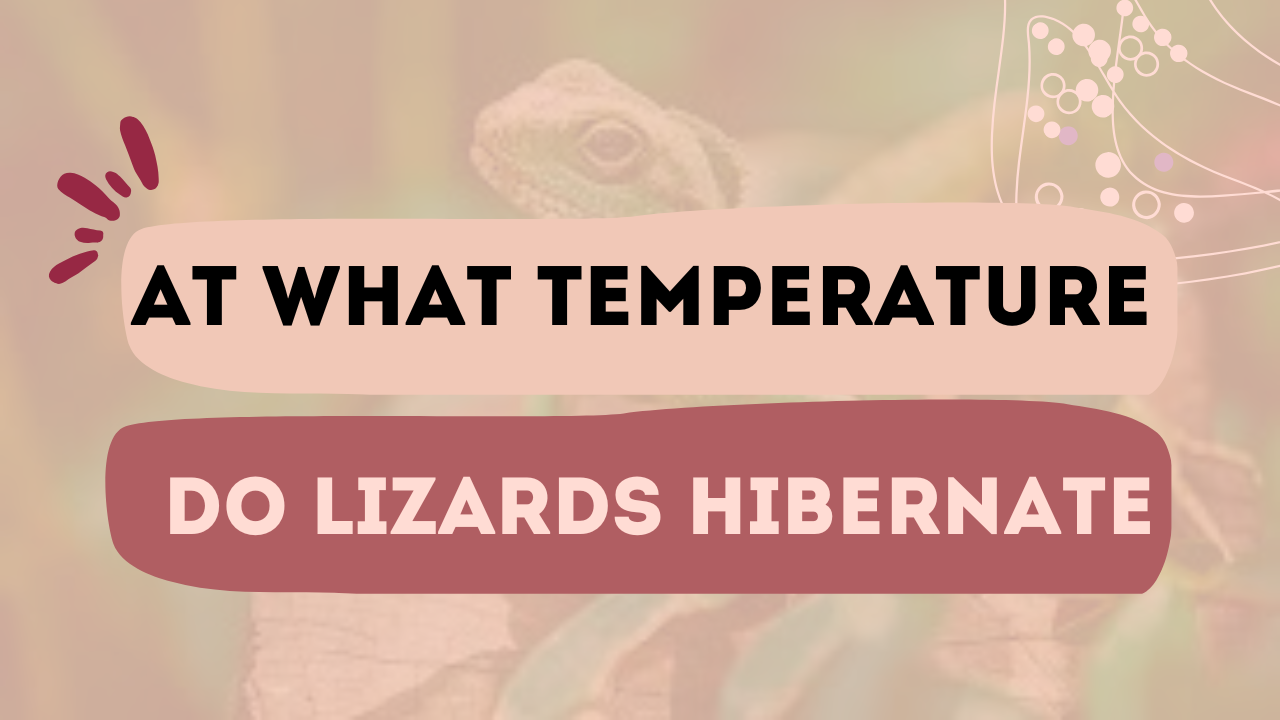Lets Discover At What Temperature Do Lizards Hibernate. Learn how cold affects their activity levels and what triggers this fascinating behavior in reptiles.
Lizards are fascinating creatures that often surprise us with their ability to adapt to a variety of environmental conditions. One of the most interesting behaviors of lizards is hibernation, or rather, brumation, as it’s more accurately called when referring to reptiles.
If you’re wondering at what temperature do lizards hibernate, you’ve come to the right place. Brumation is a process where lizards significantly slow down their metabolism and activity levels during colder months, much like hibernation in mammals.
But unlike mammals, lizards don’t enter a deep, unconscious sleep.
So, let’s dive into the world of lizard hibernation (or brumation, as it’s technically called), and get into the details of what temperature triggers this process.
What is Brumation?
Before we jump into specific temperatures, it’s important to understand what brumation is. Unlike hibernation, which is a state of deep sleep in mammals, brumation in reptiles like lizards is a period of reduced metabolic activity.
It’s the reptile equivalent of “slowing down” for the winter, where they don’t completely shut off like mammals but rather conserve energy.
The main purpose of brumation is to help lizards survive harsh weather conditions when food is scarce and temperatures are too cold for their cold-blooded bodies to function normally.
Temperature Range for Brumation
So, at what temperature do lizards hibernate or brumate? The answer isn’t as straightforward as a single number since it depends on the species of lizard and its native environment.
However, most lizards begin brumating when temperatures drop to around 50°F (10°C) or below. This temperature range signals to the lizard that it’s time to rest and conserve energy.
It’s essential to know that lizards are cold-blooded, which means their body temperature is directly affected by the environment around them. When it gets too cold, their metabolism slows down, and they become lethargic.
In the wild, this typically happens in late fall or early winter. During this time, lizards seek out burrows, crevices, or other hidden spots that help them stay insulated from the cold.
Some species of lizards can tolerate slightly higher or lower temperatures for brumation. For example, desert lizards, such as the bearded dragon or the leopard gecko, typically start brumating when temperatures hover around 60°F (15°C). However, many of these lizards will still slow down at lower temperatures, with brumation occurring more actively between 50°F (10°C) and 65°F (18°C).

Why Do Lizards Brumate?
Lizards enter brumation as a survival tactic. Since they’re ectothermic (cold-blooded), they rely on external temperatures to regulate their internal body heat. As cold-blooded creatures, they can’t generate heat the way mammals can, so they need to seek out warmth or retreat to cooler areas during extreme temperature shifts.
When food becomes scarce in colder months, brumation helps lizards conserve energy. For many species, it can last anywhere from a few weeks to several months, depending on how cold the environment gets. The process is essential for them to avoid starvation and dehydration. Without brumation, they’d exhaust their energy reserves and possibly die.
How Do Lizards Prepare for Brumation?
Before brumating, lizards typically prepare their bodies by eating more to build up fat stores. They might also seek out a safe, protected spot where they can wait out the colder months. Some species, like leopard geckos, prefer to brumate in a moist, dark location, while others, like bearded dragons, may find a burrow or crevice in which they feel comfortable.
During this time, it’s common for lizards to show signs of reduced activity. Their appetite decreases, and they may become more lethargic or inactive. If you have a pet lizard, you may notice this behavior and think they’re sick, but it’s usually just the brumation process beginning.
How Long Do Lizards Brumate?
The duration of brumation can vary depending on the species and environmental factors. In some cases, it can last anywhere from 1 to 3 months. For example, pet bearded dragons may enter brumation for around 2-3 months during winter months when temperatures drop in their environment. This period is often seen in regions where the temperatures are cooler for extended periods.
In some cases, brumation can be triggered even in warmer temperatures if there’s a sudden drop in daylight or if the lizard’s body clock signals the need to rest.
Brumation vs. Hibernation: What’s the Difference?
While brumation in lizards may seem similar to hibernation in mammals, there are a few key differences. In hibernation, animals enter a deep, sleep-like state where their heart rate and breathing slow to a near stop.
In contrast, brumating lizards are still semi-active and can occasionally move, drink, or eat if they feel the need. They don’t enter a deep, unconscious sleep, making brumation more of a slowdown rather than a full shutdown.
Additionally, brumation in reptiles is often triggered by a drop in temperature, while hibernation in mammals is more related to the lack of food and severe cold. This difference in survival tactics showcases how unique reptiles are in adapting to their environment.
Caring for Pet Lizards During Brumation
If you have a pet lizard and notice signs of brumation, there are a few things to keep in mind. First, don’t panic. Brumation is a natural process that allows your lizard to survive colder months. You should ensure that their living conditions are conducive to their hibernation period.
Keep the temperature stable, and provide enough hiding spaces for them to retreat to.
Make sure your lizard is healthy before they begin brumation. If they seem underweight, sick, or stressed, consult a vet to rule out any health issues before allowing them to enter brumation. While they won’t need food during this time, make sure they have access to water if they get thirsty.
Conclusion
In summary, lizards typically begin brumating when the temperature drops to around 50°F (10°C) or below. This hibernation-like state helps them conserve energy and survive through colder months.
The exact temperature at which brumation occurs can vary between species, but it’s generally triggered by a decrease in temperature, signaling to lizards that it’s time to rest.
Understanding when and why lizards brumate can help pet owners take better care of their reptiles and ensure they stay healthy throughout the year.
So, the next time you’re wondering at what temperature do lizards hibernate, just remember that it’s more of a brumation process that kicks in at cooler temperatures, helping these fascinating creatures make it through the chilly months.

